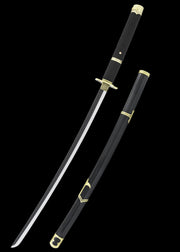This is an original DAI-SHO from Japan, with a nice KOSHIRAE
Dai (Katana): made by Fujiwara Kanesaki (Inshu) / Myoichi Bunsei 13 Nen Seishu (Edo period - Bunsei era - 1831) NBTHK Hozon Nagasa: 65.0 cm
Sho (Wakizashi): made by: Bishu Okayama Ju Kunimune (Edo period - Manji era - 1658-1661) Nagasa 40.15 cm
Details:
Dai: Katana in Koshirae (NBTHK Hozon paper)
Signature(s): Fujiwara Kanesaki (Inshu) / Myoichi Bunsei 13 Nen Seishu
Explanation: Fujiwara Kanesaki (Inshu) made this sword. Hooray Mei Myoichi Bunsei 13 Nen Seishu.
The Nichiren Buddhist quarter introduced Myuichi to Kanesaki and engraved this name on a sword tang in the pleasant clear autumn of 1831.
The blade is polished.
Habaki: Silver double Habaki
Blade length (nagasa): 65.0 cm
Sori: 1.06 cm
Mekugi: 1
Hamachi width: 2.9 cm
Width in Kissaki: 1.92 cm
Length: 0.66 cm
Era: Edo period Bunsei era. in 1831.
Shape: The blade is quite wide and thick with suitable sori and longer kissaki.
Kitae: Koitame is well-grained with a jinie weave and a soft texture.
Hamon konie deki choji midare and gunome midare
Special feature: Fujiwara Kanesaki worked in Tottori Inshu and continued until the late Edo period.
On the upper part of the signature, Myo-ichi means that the Buddhist headquarters of Nichiren presented this word to Kanesaki and wrote the name Myoichi on the tango.
Such customs occurred in the middle Edo period.
Koshirae:
Saya: Black roiro saya.
Tsuba: The shape of the kiku flower and the family coat of arms are carved on the shakudo nanako board.
Menuki: Japanese old instruments Tsuzumi and Fue
Fuchikashira: The shakudo nanako are engraved in gold on the board.
———————
Sho: Wakizashi in Koshirae
Signed: Bishu Okayama Ju Kunimune
The blade is polished.
Habaki: Silver double Habaki
Blade length (nagasa): 40.15 cm
Sori: 0.6 cm
Mekugi: 2
Hamachi width: 3.08 cm
Width in Kissaki: 2.13 cm
Length: 0.61 cm
Era: Edo period Manji era. 1658
Special feature: Bishu Okayama Ju Kunimune, He was the son of Shigeuemon era Masashige Manji.
Koshirae:
Saya: Black roiro saya.
Tsuba: The shape of the kiku flower and the family coat of arms are carved on the shakudo nanako board.
Menuki: Japanese ols instruments Tsuzumi and Fue
Kozuka: On the shakudo nanako plate, fans are engraved in gold. The back has an indentation.
Kogatana: The signature is mentioned as Inshu Jyu Kanesaki.
From Aoi Art: This pair of Daisho sets is original Daisho and in good condition.
The owner was a high-ranking samurai who used it as a Daisho set.
The condition of Tsuba and Fuchikashire is quite nice.
Daisho Kunimune and Kanesaki both do well.
———————
NBTHK Hozon Paper for Katana
Aoi Art papers for wakizashi and katana






































